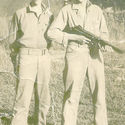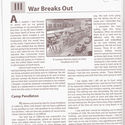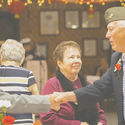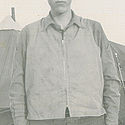MEMORIAL DAY: Healing from war comes - in time
Esko veteran finds peace in opening up.
May 24, 2019
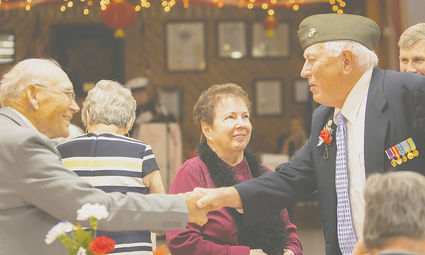
Photo courtesy Amy Louhela
Esko's Dale Erickson, right, shakes hands with Edward Kachinske, the oldest Marine at the Marine Corps Ball held at the Cloquet VFW in November. Erickson lived through the Korean War, but healing from the horrors he saw there took decades. He has written a memoir about his service, an opening up that has been part of his recovery from post traumatic stress disorder.
On Memorial Day weekend, we honor those who have died serving in the U.S. military. While Esko's Dale Erickson survived his stint in the Korean War, he came home a different person.
"Some Marines never find their souls again," he writes in his memoir. "A part of them remains missing for the rest of their lives and they forever struggle." The memoir details relentless battles, dead bodies and near-death experiences.
As we approach Memorial Day, a time when we honor our military veterans for the sacrifices they made with their lives, let us recall as well all those whose lives were forever changed by the violence, death, and terror of the battlefield.
"I was not the same person when I came back from Korea that I was when I left," said Esko's Dale Erickson, 88, as he spoke of the impact of his experience in the Korean War 1950-51.
Erickson was just 17 years old when he enlisted in the Marine Corps Reserves, B Company, 4th Infantry Battalion, stationed in Duluth.
Within two years, his unit was activated following North Korea's invasion of South Korea. The United States - along with other countries from the United Nations - stepped in to drive the North Koreans back behind the 38th parallel with the goal of halting the spread of communism. American troops fought the battles in Korea from June 25, 1950, through July 27, 1953, when the fighting stopped.
It was never a declared war and no peace treaty has ever been signed.
Some have called it the "Forgotten War" because it was never given much acknowledgment in the fabric of American society or in the history books. Even though more than 40,000 American soldiers were killed or listed as missing in action it took more than 40 years to establish a memorial to honor sacrifices in Arlington National Cemetery. For those who served, it can never be "forgotten."
This is the case for Erickson. He left Duluth with his company in August 1950. Upon arrival at Camp Pendleton in California, his group was split up. He was assigned to a weapons unit and trained for three months before arriving in South Korea in
November. The Marines were given warm clothing, but the temperature dipped below freezing much of the time. It was so cold, Erickson said, that his food froze in his kit as he walked to his tent from the mess tent.
Erickson was assigned to Weapons Company of the 1st Marine Division as an ammunition carrier for a rocket launching team. The 1st Marine Division was engaged in battle in the Chosin Reservoir, so Erickson was assigned to guard duty as he waited for his company to return. What he encountered upon their arrival was disconcerting.
He wrote in his memoir, "Killer Eyes," the returning Marines "were beat up and bloody, their clothing was a mess, they were dirty, hungry and cold." Erickson said the Marines reported suffering a large number of casualties, loading frozen bodies onto trucks, and walking out from the battle through gunfire to reach the sea and the ships waiting for them. It was a chilling introduction to the reality of the war for Erickson.
Hard realities
On Jan. 15, 1952, Erickson's unit got orders to move out. They were taken to Pohang with orders to pursue communist guerrilla forces in the nearby mountains.
From that time on, there were multiple encounters with the enemy while on reconnaissance missions. The threat of attack permeated his daily existence. The Marines were under constant mortar or artillery fire in the mountainous region.
The weather was brutally cold. Food in the rations kit was eaten despite being frozen. Sometimes fingers were too cold to manipulate a can opener to get at the food. It was during this time that Erickson had one of his most horrifying experiences.
His unit was advancing along a road and began to see frozen, dead American soldiers in their path. It was a narrow stretch with a drop-off on one side and a rock wall on the other. Erickson wrote:
"We had to walk alongside of our own trucks and tanks while our vehicles crushed the bodies with wheels and treads, creating a crimson carnage that repulsed the souls of everyone that witnessed it. ... As we walked along there was not much space between the trucks and tanks and the rock wall. We could not step without stepping on a face or arm or hand. The road was thick with this carnage and my boots were covered with blood. I could not bear to see this anymore, so I grabbed onto the shoulder of the Marine ahead of me, closed my eyes, and stumbled along with him for I do not know how long. ... It was too much to see. I could not take all the death and dead bodies. I could never get the blood off my boots after that. Part of that experience has stayed with me all my life."
Erickson wrote that he blacked out and woke up two days later on the hospital ship Repose. Government records note that about 700 soldiers were killed or executed in the valley.
Erickson said that after a week or so, he was considered sufficiently recovered and returned to his unit. In his memoir, he tells of more battles, dead bodies and near-death experiences.
He was wounded by shrapnel in June of 1951 and later hit by a bullet that grazed his webbed equipment belt and spun him around several times. There were many encounters with enemy forces and the need to kill or be killed was a constant companion.
Erickson returned from Korea and was discharged in December 1951. He was 20 years old.
When he returned to Duluth, he said he was a changed person. His family and former friends were not interested in hearing about the war. He never felt safe. He became a loner, could find no humor in his life, tried to attend college, and worked a variety of jobs.
The memories of the war were never far away. He learned to push them into a corner of his psyche in order to function. Sometimes alcohol helped to reach the "Zero Zone," a place of temporary inner peace. Marriage, family, and a career as a Duluth police officer became possible, but the impact of the war bubbled beneath the surface.
It was not until Erickson retired from the police force and began working part-time as a court bailiff that his life changed. He was assigned to a court case that involved a Vietnam veteran, and the defendant's attorney set out to prove his client's behavior was the result of post-traumatic stress disorder resulting from his service in the Vietnam War. The attorney listed 18 symptoms of the disorder - including hyper- vigilance, mood swings, sleep disorder, troubling recurring dreams, and loneliness - on a blackboard for the jury to see.
For Erickson, it was a "light bulb" moment. He had experienced all 18 of the symptoms during his lifetime and still had some of them. He explored more about the diagnosis and spoke with the local veterans service officer. Erickson was diagnosed with PTSD and began counseling through the Veterans Clinic and Counseling Services.
Through counseling, Erickson learned the importance of talking about his experiences rather than trying to bury them. Erickson said in his memoir that counseling helped him "unlock the secrets of my personal wars that I had tucked away, locked up in my secret memory bank."
As a result, he began to heal from the trauma, depression and sadness that had overshadowed his entire adult life.
He wrote in his memoir:
"Some Marines never find their souls again. They have memories that cannot be chiseled out of them. A part of them remains missing for the rest of their lives and they forever struggle with what some people call post- traumatic stress disorder."
It has taken years for PTSD to be recognized and treated in veterans. Previously, it was referred to as "shell shock" or "battle fatigue," but it was not understood by the medical field. For those who fought in Vietnam and Korea, the reality of the impact serving in war zones creates on one's psyche was ignored for decades. The Veterans Administration now reaches out to service members and encourages them to seek help.
Of course, PTSD also appears in the civilian population as a result of exposure to life-threatening events. Individuals are encouraged to seek professional help to address the symptoms of PTSD and begin the healing process.
Erickson continues to reflect on his deep understanding of war. "We have to find a way for diplomacy to work," he said. "No more boots on the ground."
Finding help
Suspect you have PTSD or other lingering effects of warfare or trauma? Reach out to any of the these agencies for help.
•Veterans Crisis Line: 800-273-8255, VeteransCrisisLine.net. or text 838255.
•The Carlton County Veterans Service Office: 14 N 11th St. Suite 120, Cloquet, MN 55720. Email Duane Brownie, Veterans Service Office, at [email protected]. Phone 218-499-6838
•The National Alliance on Mental Illness (NAMI): http://www.namidulutharea.com. National Institute of Mental Health: http://www.nimh.nih.gov 866-615-6464
Events
Cloquet area
The American Legion Post 262, Cloquet VFW Post 3979, Disabled American Veterans Chapter 18, American Ex-Prisoners of War and their auxiliaries will visit 10 cemeteries in the following order on Memorial Day:
8:15 a.m. — Highway 210 Cemetery, Sawyer
8:30 a.m. — St. Mary and Joseph’s Cemetery, Sawyer
8:45 a.m. — Holy Family Mission Cemetery
9:15 a.m. — Maple Grove Cemetery
9:30 a.m. — New Calvary Cemetery
9:50 a.m. — Hill between old cemeteries above Pinehurst Park
10:20 a.m. — Apostolic Lutheran Cemetery, Esko
10:45 a.m. — St. Matthews Cemetery, North Cloquet Road
11:05 a.m. — Pine River Cemetery, North Highway 33
11:30 a.m. — Veterans Park, Cloquet
Carlton area
The Carlton VFW Post 2962 Honor Guard along with Post and Auxiliary members will visit eight cemeteries on Memorial Day. The schedule follows:
7:45 a.m. — Eagle Lake Cemetery, Cromwell
8:10 a.m. — Cromwell Cemetery
8:50 a.m. — Atkinson Cemetery
9:30 a.m. — Elim Lutheran Cemetery
9:55 a.m. — Oak Lake Cemetery
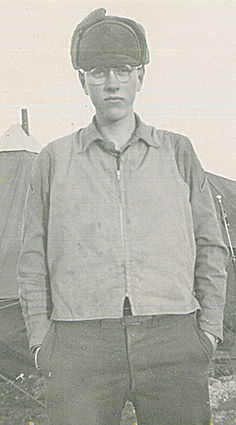
Photos courtesy Dale Erickson
Dale Erickson was a teenager when he joined the Marines, eventually serving in Korea. Once there, he learned to rely on his fellow soldiers to get through the daily brutality he encountered. Photos courtesy Dale Erickson
10:25 a.m. — Holyoke Cemetery
11:05 a.m. — Silver Brook Cemetery, Wrenshall
11:30 a.m. — Hillside Cemetery, Carlton
There will be a potluck at the Carlton VFW, 124 Chestnut Ave., at noon Monday. Any and all are welcome.
Other events
•There will be a memorial program at 10 a.m. Monday at the Moose Lake School, followed by refreshments by the Legion Auxiliary from 11 a.m to 1 p.m. at the Soo Line Event Center in Moose Lake.
•The Floodwood VFW will perform its annual Memorial Day military rites at Veterans Memorial in Wright at 11 a.m. Monday. Coffee and treats will be served at Bethlehem Lutheran Church after the ceremony for those who wish to visit.


